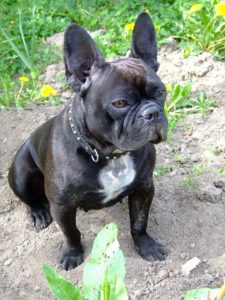I was really happy to finally get my little Frenchie, Rosie. She is really just a ray of sunshine in my life, and her cute little actions always make me smile.
 I am so proud to be a dog owner!
I am so proud to be a dog owner!
It wasn’t always this easy, though. I had never had a French Bulldog prior to this.
I first fell in love with the breed when visiting a cousin over the Christmas holidays. I happily adopted one of my own soon after.
I wanted to train Rosie to be the best dog possible, but there was so much good advice out there I got overwhelmed!
Therefore, I wanted to condense it all down and pass along to you the best advice I could.
Hi! My name is Steve, and I can’t wait to tell you about my tips for training your French bulldog.
I first learned of these great techniques when I was reading The French Bulldog Guide’s article about How to Train a French Bulldog Puppy.
I settled for these methods, and I find that they are really effective. They certainly worked for my friends, too!
Potty Training
This is a skill that will be essential for leaving your dog alone during the day. It will also help create good potty habits, too.
For good potty habits, take your Frenchie outdoors where you want him or her to go.
Use a keyword when it’s time to pee or poo, like “Let’s go potty!”
Someone I know tells their dog “Hurry up!” in a kind, friendly tone of voice.
It’s just a phrase the dog knows to mean it’s time to make a poop, so they can go back inside. Be firm but gentle. Don’t let him get distracted.
 Once your Frenchie makes his poo, offer praise and a pet.
Once your Frenchie makes his poo, offer praise and a pet.
If he does not go within 10 minutes, take him back to the crate and try again in 10 minutes.
Repeat until the dog relieves himself.
Be sure to repeat this routine after each and every meal so that your pup gets in the habit of going right afterward.
Take him or her out first thing in the morning, and then at night, too.
If you are very busy working check here to learn how to potty train your dog while you work
When it comes to crate training, bear in mind that your dog will not relieve himself where he sleeps, provided the crate is the right size.
Choose a crate that will allow him to stand up, sit down, and turn around comfortably.
Rosie loves her crate, and it is just the right size for her. I set it up with a soft old blanket and one of her favorite toys.
Dogs do not mind being in their crates. It gives them a special place to call their own.
Dogs, like their wolf relatives, are den animals and enjoy having a space like this.
Crate Training
This process can take anywhere from a few days to a few weeks.
It is all a matter of your dog’s temperament, age, and any past experiences they may have had with crating.
Just make sure that you make the crate a nice place to be and associate it with pleasant things like treats and toys.
If you need help finding a great crate for your dog check out this article!
 As previously mentioned, Rosie loves her crate because it has a nice soft blanket, a toy, and is located near one of the heater vents in my home.
As previously mentioned, Rosie loves her crate because it has a nice soft blanket, a toy, and is located near one of the heater vents in my home.
She is now capable of staying in there all day until my wife comes home and lets her out on lunch break.
It was not always this easy.
You can set a good foundation for crate training by doing the following:
Start by bringing your Frenchie over to the crate and use a calm and happy tone of voice.
Open the crate and leave the door open so it will not hit the dog and cause panic.
Drop a few small treats in there so they go in and explore it. Use as many treats as needed until they go inside.
I lined them up in sequence, so Rosie would go right inside.
Next, feed your dog near the crate. Ours is in the kitchen, and we eat our meals at the kitchen table, so Rosie associates the crate with meal and family times.
I first fed her near the crate, and then moved her dish to the back of the crate so that she knew it was an okay place to be.
Once she was inside eating the food, I closed the door quietly. At first, I let her out right away.
I then left her in there for a few extra minutes each time. She whined a little at first. I did not let her out right away, as this would have taught her this is how to get out of the crate.
Just keep them in there for a small period of time and talk them through it.
 Once your Frenchie is okay with eating meals inside the crate, you can leave them in there for a short period of time while you’re at home.
Once your Frenchie is okay with eating meals inside the crate, you can leave them in there for a short period of time while you’re at home.
Start by calling them to the crate and giving them a treat. Then say, “crate” and point to the crate door so they enter.
Hold a treat in your hand so they are encouraged to go in.
Once inside, give them the treat and praise them for being good.
Close the door and stand nearby for about 5-10 minutes. Go into another room and come back after a few minutes.
Then come back and stay for a few minutes. Afterward, let them out.
Keep repeating this throughout the day. Gradually increase how long you leave them there so as to get them used to the crate.
Once they get to about 30 minutes of crate time without you being there, you can leave them in for short time periods while you’re gone.
Then you can work up to having them sleep in the crate overnight. Just be patient!
It took a good month for Rosie to become fully comfortable with her crate.
Now she stays in overnight, the heater keeping her toasty.
General, Good Tips
Now I’m just gonna go over some good tips for training your Frenchie in general.
These are just some good ideas I found out over time.
Keep things consistent.

Set a schedule for feeding, potty time, and walks. It’s best to get up and take your dog out for a walk as soon as they wake up, and also after food and drink.
This way, they know when to go. You might even take away water a few hours before bed to prevent accidents.
Frenchies are naturally very clean dogs. Therefore, it is key that you get them crate trained.
If you limit their space, they will see that as their living quarters, and thus refuse to relieve themselves there.
They don’t like to pee or poo where they live.
- Look for signs that they have to go.
My Rosie would circle the room.
They may pace from one room to the next. They might bark or whine. Just keep an eye for this stuff.
This means they gotta go-so get them to their potty spot right away.
Make sure your pup has a special command word in his or her memory so that he knows when he hears that word, it’s time to go potty.
If your pup starts to go where they shouldn’t, say the phrase, which might be something like “Go Potty” and then take them outside or to the puppy pad.
Give them a treat once they are outside and going to the bathroom. They will then be able to signal to you they need to go outside.
Rosie will stand at the door and whine a little when she really has to go.
Most of the time, I remember to take her out, but she will whine when it’s time.
Be sure to clean up any indoor accidents quickly after they happen.
Make sure that they are cleaned up completely using a household cleaner designed to get rid of pet urine odors.
It is critical that you get rid of any dog urine and feces odor, because doing so means they will be less inclined to go in that spot again.
You might even move the poo to the potty spot outside and show the dog so that he knows where he should be going.
Final Thoughts
 You can easily train your French Bulldog. It is going to take time, and it is going to take patience.
You can easily train your French Bulldog. It is going to take time, and it is going to take patience.
Just be sure to remain calm and keep a positive attitude.
With anything, it is best to approach your dog with plenty of treats, praise, and patience.
Remember not to give in and let your puppy out when he or she starts to whine, especially during crate training.
Stay firm and know that your dog can do this.
Make sure to make their crate a comfortable, safe place to be, and put it in a place where the family gathers, like the living room or kitchen.
Once potty trained you may want to train your dog to do a range of amazing tricks, if this sounds good click here!
We hope you liked this post!
Share the post and leave a comment with your ideas about training a French Bulldog.
Rosie and I would love to hear it!

